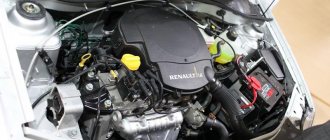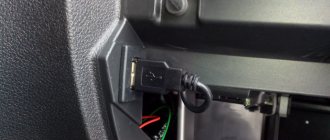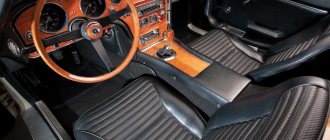Lada Largus appeared in Russia not so long ago, but has already become popular among car enthusiasts. The model belongs to family cars, the main purpose of which is the transportation of things, cargo and out-of-town trips. One of the versions of Largus is Cross, which has some differences both in appearance and in technical characteristics. But since this is a domestic car, many owners make various modifications to the car.
- Engine
Chipovka - Technical improvement
- Video: increasing ground clearance using the example of Logan
- Optics modernization
- Tidy improvements
- Photo gallery: tuned Lada Largus Cross
How to upgrade a mediocre Lada Largus station wagon to a top version for little money?
avtoexperts.ru
Absolutely any car can be tuned and improved, Lada Largus is no exception. However, this car differs from other models in its class. If the modifications of other cars are often of a typical nature and are the same for all cars (cooler music, xenon, lenses, armrest, sound insulation, and so on), then Largus has tuning areas that are typical only for the VAZ station wagon and which make a lot of sense for other cars Dont Have. This is exactly what we want to talk about in this material.
In the photo - Lada Largus VIP - a special version of the car.
Replacing fifth gear gears
This, of course, is nonsense, but intervention in the gearbox is one of the most popular tuning options for Largus. It's all about the mocking selection of gear ratios on cars with new engines. There is no point in nodding towards VAZ engineers here, because they received such a setup along with a production license; in Europe, the Dacia Logan MCV is produced with the same gearboxes. What is the problem? The box is very short. In the highest, fifth gear, at 3000 rpm, the car travels only 91 km/h according to the navigator. Normal cruising speed of 120-130 km/h, allowed on toll sections, already requires 4000-4500 rpm. It is uncomfortable to drive for a long time at such a speed, because the engine roars as if it was about to take off. And fuel efficiency suffers from this setup.
Speedometer readings with original gears. Engine 1.6 16 valves.
Surprisingly, the problem is most pronounced on cars with a 16-valve engine, which have the shortest gearbox. The van and modifications with an 8-valve power unit have different gear ratios, also short, but more humane for the driver. So, an 8-valve 5-seater Largus at 3000 rpm will travel about 100 km/h according to GPS. Already more or less. Any automotive student knows that the weaker the engine, the shorter the box it needs to hide the lack of horsepower, while on more powerful engines you can put long pairs, because the engine will still take out. But this truism is inaccessible to the understanding of French engineers.
Speedometer readings for the 8-valve version of Largus at 3000 rpm.
Considering that Largus’ 16-valve engine is the most popular, the problem is widespread. Fortunately, it turned out that it is possible to change the fifth gear gears on a Renault gearbox without removing and disassembling the unit. The highest speed is located directly behind the removable cover, and just on the side with good access. Technically, the replacement looks like this: you need to remove the wheel, wheel arch liner, unscrew the bar, drain the oil from the box, unscrew the box cover, remove the old gears, install new gears and reassemble in the reverse order. You need good pullers for the job, because the hardest part of the process described above is removing the old gears. If you don’t have the necessary equipment and don’t want to buy it for one time, then you can contact any service center to ask for a replacement. They will charge 2-2.5 thousand rubles for the work.
Fifth gear gears Lada Largus
Another question is what to put. In total, Renault produces five gear options for JH3 gearboxes, which provide different gear ratios: 0.892; 0.820; 0.795; 0.756; 0.738. As you might guess, 16-valve Largus have the shortest ratio - 0.892, so any replacement will improve the situation. But the owner needs to choose for himself what specific ratio to set. The optimal option is 0.795 - and the speed on the highway is reasonable (at 3000 approximately 102 km/h according to the navigator), and the dynamics are maintained. But for some reason this particular set turns out to be the most expensive. To save a little, you can take 0.756, which at 3000 rpm will have 105 km/h. The longest option is uncomfortable, because between 4 and 5 speeds there is a huge gap and at a speed of 70 km/h it is uncomfortable to drive in any of these gears.
Speedometer readings after replacing a gear with a gear ratio of 0.756
After replacement, fuel consumption on the highway usually drops, but not very much: by 200-400 grams. It will not be possible to recoup the costs of replacing gears with fuel - the difference is too small, and gears cost about 5-6 thousand rubles. The main point of tuning is a comfortable ride on the highway. After the replacement, you can drive relatively quickly and not hear the straining roar of the engine. This is also worth a lot.
Note that replacing the gear is only relevant for passenger Largus. The van already has the longest 0.738 from the factory, but it works in combination with a “cargo” main pair of 4.928, which compensates for the length of the fifth gear itself. But you can’t easily change the main pair in the box.
In addition, all of the above is typical only for models with a Renault engine. When switching to VAZ engines, engineers changed the entire number of gears, so now the Largus can be comfortably driven on the highway straight from the factory.
Spare wheel on the trunk door
A spare tire on the tailgate is considered the preserve of jeeps. But on Largus this element is found very often. Why? The VAZ station wagon is perfect for installing LPG, and the cylinder simply fits perfectly under the rear overhang, in place of the spare wheel. But then where to put the spare tire? In the five-seater version you can simply throw it in the trunk, but in the seven-seater you can’t do this - it just doesn’t fit in width between the seat back and the door. Out of desperation, I have to mount it from the back, fortunately several companies have started producing brackets.
Spare wheel bracket for Lada Largus
For about 3500-4000 rubles you can buy a ready-made version, which is easy to install yourself using fasteners on the door itself. Depending on the manufacturer, the kit may include a plastic or leather case, often with the model name; there are different options for mounting bolts, including those with secret locks.
Spare wheel on the rear door of Largus
The bracket solves the problem of storing the spare tire, but creates some others. The load on the door hinges increases, so it begins to sag over time, and the not-so-good view back becomes even worse, because the right side is completely blocked by the wheel, and access to the trunk with such a spare wheel is less convenient. In addition, moving a spare wheel is an intervention in the design of the car, which, in an amicable way, needs to be formalized. This is difficult and expensive, but otherwise there may be problems with the traffic police and passing technical inspection.
Additional lights
Largus, by all means, cannot be called a beautiful car, but one design element, even by the standards of the rest of the car, looks, dare we say, ugly. These are plastic pillars above the rear lights. Even in the maximum configuration, they are unpainted and look like a foreign body against the background of the rest of the body (especially white), so it is not surprising that on sale you can find several options for additional lights that are installed instead of these plastic covers.
On the left is Largus with additional backgrounds, on the right is the stock version.
Flashlights come in different varieties; the latest generation even includes LEDs. In terms of functionality, they replicate the rear optics - that is, they work as dimensions and as brake lights. Additional lights should improve the visibility of the car, but still the main goal of this tuning is appearance and getting rid of unsightly black overlays. The cost of the kit is about 2500-3000 rubles, installation is simple and straightforward. The lights themselves are bolted on, and power is taken from the standard wiring.
Lada Largus with additional rear lights
Flat floor and sleeping area
The trunk of passenger Largus is good in everything, except for one thing – a flat floor is not possible in any configuration. This is not very critical for transporting goods, but what should owners who want to spend the night in the car do? You need to make a level floor: either yourself or buy a ready-made one; fortunately, carpentry craftsmen also understand the needs of the owners.
Flat floor design for Lada Largus
There are two concepts. The simplest and cheapest option is to make a folding structure that will cover the space created when folding the second row. There is a small drop and a short length. Ready-made, plywood, carpet-covered options sell for 4,000-5,000 rubles. You can do it yourself cheaper. But the option is so-so - from the folded seats to the rear door there remains about 180 cm. Not enough for tall people to sleep.
Largus with a flat floor
Therefore, there is a second option: do not fold the back seat completely, but simply lower the backrest and level the floor with it. The backrest in the lowered position has a slope, so you need to lay the flooring on its upper level. On one side the structure will rest on the back, on the other you need to make legs or drawers. There are many options for such sleeping bags on sale, with a huge range in price depending on functionality, but we haven’t seen any options for less than 15,000 rubles. For self-production, this option is much more difficult. But the length of the sleeping place turns out to be about 2 meters, which is comfortable for the vast majority of people, and under such flooring there is space for luggage, which can also be important.
Flat floor in Lada Largus - option N2
But there is an even simpler way to spend the night relatively comfortably in Largus, although it is only available to owners of the seven-seater version. The trick is that if the backs of the second and third rows are lowered, then their top points will be at the same level. All you have to do is buy an air mattress measuring approximately 130 by 190 cm, and it will perfectly cover the entire space from the front seats to the rear doors, and will rest directly on the backrests. Between the seats, of course, there remains emptiness, but the inflated mattress does not sag even with two points of support, in addition, this space can be used for storing things. This design has only one drawback - taking into account the air mattress, it turns out to be quite high, there is about 50 centimeters in height left to the roof, so you won’t be able to sit in the car. But you can sleep well - if necessary, you can hang your legs over the front seats, so this option is suitable for people of absolutely any height. It is also the cheapest - a mattress with a pump will cost no more than 1500-2000 rubles, and nothing more is required for this type of overnight stay.
Air mattress in seven-seater Largus
Plastic cover for windshield wipers
Renault engineers clearly failed to design the windshield wipers. Not only is the trapezoid unsuccessful and the right blade leaves a smudge in the middle of the glass (this was corrected in later versions of Largus), but also the space between the wipers and the hood is not covered by anything. Dirt and leaves constantly accumulate there, which then enter the air intake and fly through the stove into the cabin (until 2021, the Largus did not have a cabin filter).
Cover for the windshield wiper opening (Jabot)
In general, it would be good to close this space, fortunately, cooperatives here also offer ready-made versions of plastic frills. There are two modifications. In the first, the plastic is simply glued to double-sided tape - simple and cheap (about 800 rubles), but not in a bad way: this design doesn’t hold up well. The second modification is more expensive and more complex, but it uses additional fasteners in standard places on the body (they exist). This option is, of course, preferable. It costs approximately 1500 rubles.
Installed Jabot
Overall, Largus is an excellent tuning target. Relatively low cost, wide distribution and the availability of ready-made options make it possible to seriously modify the machine. And, of course, the car has a lot of initial flaws in design and production, which these modifications are designed to eliminate. Over the years of production, the plant still corrected some of it on its own, but there is still a lot left. Judging by the first photographs of the restyled model, the body will not change much, so all the modifications described above will have a long life.
How to choose an alarm?
Today's market is able to “stun” the buyer with the widest range of security systems offered. They are differentiated by their price categories and the range of their security functions and capabilities. In any case, the main goal of all systems is to provide a sufficient level of protection for the car from sudden attacks, and not every alarm system is a reliable car protector.
Some types of alarms require inclusion in so-called security systems, whose level of protection is significantly higher compared to budget versions of devices. Here the buyer should determine the needs for protecting his station wagon. If this issue is resolved, then we pay attention to the applicability of the system you like to the Lada Largus. It should be remembered that more complex devices are more difficult to install, so unless you are confident in your own experience, the owner is advised to contact the appropriate center. Installation can also be done by hand; connection points are used for this.
Most systems offered on the market include a standard list of components:
Chip tuning Largus Cross - small adjustments for grandiose changes
Despite its complex design and a huge number of new products in the field of automotive electronics, everyone can perform chip tuning of the Largus engine with their own hands. All you need is a little patience, computer hardware and licensed software. The latter includes:
- Combiloader loader, updated to the latest version;
- Firmware purchased strictly from the official website. For chip tuning the Lada Largus Cross, the Bosch 7.9.7 utility or the latest version January 7.2 is perfect;
- editor for configuring and calibrating firmware;
Programs and equipment for chip tuning Lada Largus
As for the equipment, for effective work on flashing the engine ECU, you need a K-Line adapter and a laptop exclusively with Windows XP. Other software will not find the firmware, which is why you will not be able to even start chip tuning.
Having all the equipment available, you can get to work. First you need to find the Lada Largus ECU. It is located behind the rear lid of the glove compartment in the station wagon. We disconnect the shield, connect the adapter and turn on the car ignition. Next, we proceed to install the programs.
First in line are the loader and editor. After their successful installation, we begin to work with the firmware. To do this, install it on your computer, indicating the final location address in the previously installed bootloader. When the latter finds the firmware, you need to configure it. In the “Settings” window you will find a lot of graphs that will help you choose the optimal characteristics for your station wagon.
Lada Largus ECU firmware
Having calibrated the firmware to your liking, turn on the ignition and proceed to the most important stage of chip tuning - installing the firmware on the engine ECU. To do this, click on the “Run” window and wait for the utility installation to complete. Once the download line reaches the end and you see the “Download Complete” window, turn the ignition back on and close the installer. Next, close the bootloader and editor and turn off the ignition. After this, disconnect the adapter from the laptop and ECU.
At the last stage, you can check the operation of your car. Provided that the characteristics are properly calibrated and chip tuning is performed correctly, you will immediately notice an improvement in car dynamics, a reduction in fuel consumption by about 20%! and more stable operation of the engine and transmission.
We recommend: Executive cars: the best models of business sedans
Modification of the rear wiper
Unfortunately, the rear wiper operating mode on the Lada Largus does not have an intermittent mode - when turned on, it works constantly.
To switch the wiper to work with a variable pause, use:
- wiper relay marked 723.3777;
- standard 4 or 5-pin connector for automotive relay;
- round terminals;
- terminals 3 mm wide (“male + female”);
- pieces of wire;
- heat shrink tubing for insulating connections.
To connect an additional relay, ground wires are used that have black markings on the steering column switch block (third from the right on the side of the wires), as well as turning on the rear wiper (white, second from the right) and turning on the rear washer (gray, far right).
The rear wiper of Lada Largus can be modified by installing an additional relay
An additional relay is installed in the gap between the block and the wire route. At the same time, in order for the electrical circuit to be returned to its original state without any problems, standard connectors and terminals are used to connect an additional relay.
The principle of the modification is that when the rear wiper is turned on, the voltage previously supplied to it directly is now supplied to an additional relay, which, after modernization, controls the operation of the wiper, providing the necessary pause between strokes.
An additional advantage of using this relay is that when the rear washer is turned on, the wiper automatically switches to continuous operation mode, and after 3-4 cycles it again switches to pause mode.
The entire structure is mounted next to the steering column switch and secured with plastic clamps.
Interior improvements — Lada Largus, 1.6 l., 2013 on DRIVE2
Ever since I bought the car, I have had a desire to do interior tuning. Body tuning is practically not interesting to me. But the inner world, my personal space behind the wheel, that’s what I love. I do it only using original spare parts from our RENO brethren, in order to exclude collective farm tuning. I emphasize that I want to achieve not luxury, but harmony of colors and decorative elements, without drawing attention to details. So that people unfamiliar with our car would think that everything is as it should be. In general, I decided to remove all silver-painted plastic from the interior. I didn’t do it quickly, without fanaticism. First, I replaced the rims of the deflectors with chrome, then I installed the climate control handles from a Duster, then the interior handles from luxury Dusters. This was the easiest thing to do. And now it's time for the dashboard and door inserts. Here's what we managed to do. 1. I removed the silver from the dashboard (in front of the steering wheel), I removed it by purchasing a used Renault tidy. I disassembled my device, pulled out the frame,
Say a word about Largus Cross
The Cross version is the case where changes can be kept to a minimum. If I had a choice between Largus and Largus Cross, I would without a doubt take the second one. And I would recommend this to everyone.
The car initially, if taken in a good configuration, minimizes the need for tuning. Everything I said before applies here.
But in practice, only some of the improvements are really useful in this case. I explain my position. The Cross version initially offers:
Installing a handbrake warning light
The parking brake, according to reviews from Lada Largus owners, is quite powerful for this car. So attempts to move with the handbrake raised usually end in failure.
Although slightly releasing the handbrake, even after several tens of meters of movement, does not add life to the rear pads.
To protect your brake pads, install a handbrake warning light.
In order to avoid such curious mistakes when starting to drive, especially since the standard “handbrake raised” alarm lamp is not very informative, some motorists install an additional handbrake alarm unit.
The unit itself is commercially available, and its connection is quite simple.
The unit itself has four wires for connection. They all connect to a black connector that matches the instrument cluster.
Color coding and connection:
- the positive from the ignition is connected to pin 10 (yellow wire);
- a speed sensor is connected to pin 22 (green wire);
- the remaining two gray wires are connected to slot 16 (gray wire).
Now, if you start driving with the handbrake raised, a buzzer will sound and the parking brake lamp on the instrument panel will begin to blink.
Self-installation of alarm systems
Stage one
Before directly installing the device on a LADA Largus car, we resort to a preparatory process concerning: an alarm unit, an immobilizer bypass module, auxiliary equipment, a list of tools and fasteners. A detailed study of the documentation supplied with the system will also be required. We forget that the device has certain connection points.
Stage two
We begin disassembly with the steering column casing. Unscrew the screws securing it with a suitable screwdriver. Now we dismantle the decorative trim present on the panel above the pedals.
Stage three
Let's move on to the actual installation of the alarm system. We wrap the cables with insulating tape in such a way as to ensure the ability of the device connection points to respond in a timely manner in the event of an aggressive impact on the body from the outside. This approach can justify the secrecy of the location (behind the cover) of the main module of the system. It will be difficult for attackers to get close to him here.
Stage four
We integrate a diode light bulb into the body pillar, and an antenna onto the inner surface of the windshield. At the same time, we install the power supply and switch the cables included in the kit. The crimped terminal must correspond to the negative contact. It is secured with a nut. It is better to lay wiring in door openings, which will prevent kinks and other impacts on the main electrical lines.
Stage five
The cable harness is pulled into the engine compartment of the LADA Largus through a rubber seal. Using a similar principle, we install the limit switch and siren. The next step is to connect the system with turn signals. Then we proceed to the installation of the door limit switches and the luggage compartment.
Stage six
The security system in LADA Largus has a direct connection with the tachometer, central locking and manual parking brake. Special relays can be integrated into the alarm circuit to prevent the engine from starting during an attack by intruders on the car.
Stage seven
Now let's start programming the alarm function. Here it is necessary to achieve coherence in the functioning of the motor and tachometer. The shock sensor may also need to be adjusted.
Installation of the Starline A91 alarm system and immobilizer crawler with your own hands
I welcome everyone who is interested in this machine to my page. Before him, I drove a Lada Seven. My wife and I were thinking about purchasing a new car, because the seven was constantly falling apart and it turned out that it was not I on it, but it on me. And since we don’t have much choice in Yakutsk, the choice fell on Largus. I read a bunch of reviews about him and decided that he was right for us. Meet a Russian-citizen Frenchwoman with Romanian roots! Lada Largus 2013 1.6 l, 105 hp. 16 valves, 5-speed manual transmission Luxury equipment: power steering, air conditioning, 15″ casting Heated front seats Power windows on 4 doors ABS, heated electric mirrors On-board computer, Athermal glass, Adjustable leather steering wheel, Daewoo audio system (FM+CD+MP3+ AUX+Bluetooth+Hands free), 4 speakers, central locking, immobilizer, headlight range control, 2 airbags, fog lights, broom, separate rear seats.
We are asking 6-7 thousand rubles for installing an alarm system and an immobilizer bypass, and since I already installed an alarm system, albeit on a VAZ 2107, I decided that I could handle it myself. I collected information on the Internet, put it together and began the installation.
First of all, remove the steering shaft trim. To do this, unscrew 2 screws under the steering wheel.
Unscrew the 2 screws and remove the instrument panel trim. To remove the instrument panel, you need to unscrew 4 screws.
Unscrew and remove the VSM block. It is located under the dashboard near the hood release handle.
In the left pillar we stretch the wires of the alarm antenna and LED
Shock sensor and LED
We install a siren, a limit switch (cut off 3 divisions) and a temperature sensor under the hood
We route the wire under the hood through the standard rubber band on the driver's side
We attach the alarm unit with two clamps (ties) to the transverse beam of the body behind the instrument panel
To bypass the standard immobilizer, we put the bypass module frame on the ignition switch
On the black chip of the tidy:
My tachometer is beige, you can have gray (auto) (4 from the left) + gray-black (signal)
Handbrake gray (auto) (4 on the right) + orange-violet (signal)
Central locking: orange (auto) closing + green (signal) pink (auto) opening + blue (signal)
Limit switches: green (auto) + beige-white (signal) trunk and rear doors orange (auto) + blue-black (signal) front doors
Turn signals: white (auto) + green-yellow (signal) beige (auto) + green-black (signal)
+12v - Red (auto) + red (signal) ACC - Yellow (auto) + green (signal) / ACC Ignition - Pink (auto) cut + black-yellow thick (signal) towards the starter and black-yellow thin (signal) ) towards the ignition switch
Connect the immobilizer bypass to the pink alarm wire
Source
Step-by-step instructions for installing the Starline A93 alarm system
p, blockquote 10,0,0,0,0 —>
Preparatory work
At the preparatory stage, it is important to provide for all the nuances, otherwise, if the need for some small detail or tool suddenly arises, this may stop the work for some time. The car will be motionless at this time.
p, blockquote 11,0,0,0,0 —>
What is required to complete the work.
p, blockquote 12,0,0,0,0 —>
First, tools and equipment:
p, blockquote 13,0,0,0,0 —>
It is equally important to prepare consumables, especially since when installing the Starline A93 alarm system, many professional auto electricians complain about the insufficient length of the conductors included in the delivery kit.
p, blockquote 14,0,0,0,0 —>
p, blockquote 15,0,0,0,0 —>
Car maintenance and repair: when to do it
Let's stop there. There are really a lot of options, since at a minimum you can repaint the body, do airbrushing, tint the windows, increase the ground clearance, and so on.
In the photo you will see what Largus can look like with little investment and serious tuning costs. It’s up to you to choose, a banal sizing of some linings, or an integrated approach with a radical change in the body, interior and more. Prices for tuning will be completely different, but the result will be appropriate.
Let's sum it up
The owner should decide in advance on the installation location of the main alarm module, after which he can begin planning the procedure for wiring sensors around the perimeter of the body.
Installation, as we have seen, is not too complicated, which allows it to be accessible to most Largus owners, the main thing is to know all the connection points. You should not neglect to study the instructions in detail, which will significantly simplify the subsequent installation process, then the alarm will work flawlessly.











